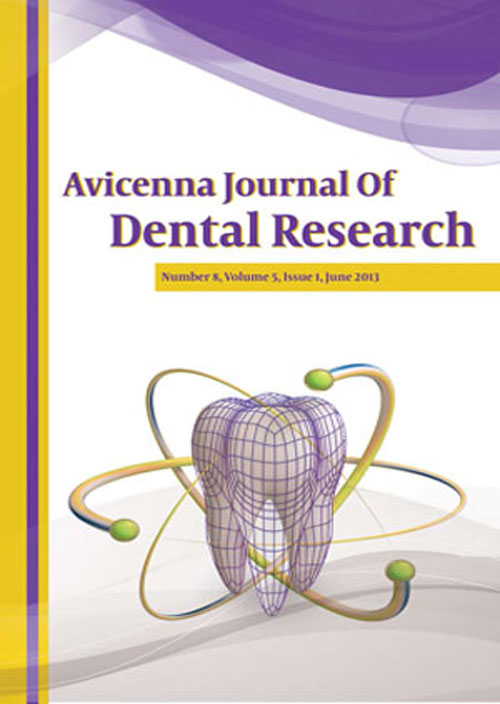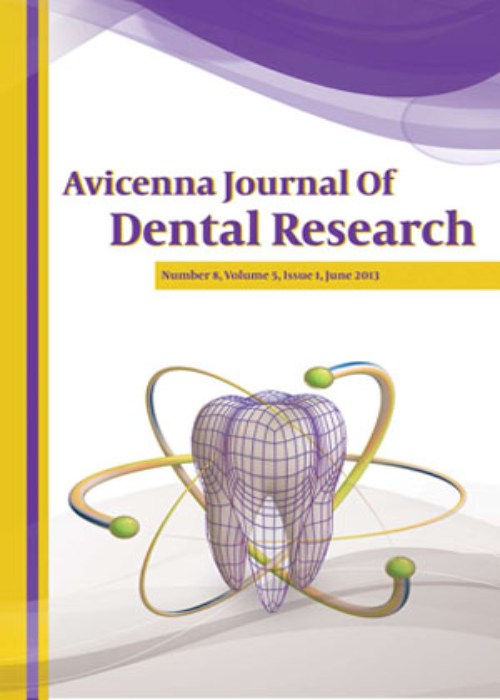فهرست مطالب

Avicenna Journal of Dental Research
Volume:12 Issue: 2, Jun 2020
- تاریخ انتشار: 1399/10/10
- تعداد عناوین: 7
-
-
Pages 35-39Background
Oral pathogens can affect a large population and the general health of individuals. Based on the evidence, the grape seed extract (GSE) contains herbal compounds that have the ability tosuppress oral pathogens associated with caries and fungal diseases. In this regard, the current studyaimed at evaluating the effect of GSE on Streptococcus mutans and Candida albicans.
MethodsThe grape (Vitis vinifera L.) seed was used in this in-vitro experimental study. After thepreparation of methanolic GSE, its effect on S. mutans and C. albicans was assessed at 0.25-256 mg/mL concentrations. Then, the minimum inhibitory concentration (MIC) and minimum bactericidalconcentration (MBC) were determined by macro broth dilution methods. Finally, data were analyzedby SPSS, version 20.
ResultsThe results showed that GSE inhibits the growth of S. mutans and C. albicans. In addition, theMIC and MBC of the extract against S. mutans and C. albicans were 2 and 8 mg/mL, as well as 32 and64 mg/mL, respectively.
ConclusionsIn general, GSE had a significant antimicrobial effect on S. mutans, while it only affected C. albicans at high concentrations.
Keywords: Grape Seed, Extract, Streptococcus mutans, Candida albicans, mutans -
Pages 40-45Background
Age estimation is a fundamental part of forensic science. Considering the fact that pulp size decreases throughout the life because of secondary dentine apposition, many researchers have used it as a method for age estimation with great results. This study aimed to determine the applicability of tooth to pulp ratio in mandibular second premolars in an Iranian population using panoramic radiographs.
MethodsThe sample consisted of 153 digital panoramic images of male and female Iranians aged 13-70 years, and the tooth to pulp ratio of both left and right mandibular second premolars was obtained using AutoCAD software. Analysis of variance (ANOVA), Pearson’s correlation, and regression analysis were used to analyze the data. A total of 20 images were reexamined after 30 days to test intra-observer error.
ConclusionsTooth/pulp ratio of mandibular second premolars is a reliable and repeatable method for age estimation in Iranian population and using premolars of both sides yields the best results.
Keywords: Age estimation, Cameriere’s method, Chronological age, Panoramic radiograph, Pulp area, Forensic science -
Pages 46-50Background
Screw loosening is one of the most common problems associated with implant-supported prostheses. The type and material of the abutment play an important role in the esthetic appearance of implant-supported restorations. Metal abutments create an unaesthetic grayish halo in the gingival margin of the implant due to the reflection of light from the surface of titanium abutment. Zirconia is highly popular for the fabrication of abutments due to its optimal color, along with the quality of light transmission and its resistance. The present study aimed to evaluate the torque loss in titanium and one- and two-piece zirconia abutments under cyclic loading.
MethodsIn general, 24 abutments in three groups (n=8) of one- and two-piece zirconia abutments, and titanium abutments were evaluated in this experimental study. The abutments were attached to the analog of fixtures with 30 N/cm torque and the samples were subjected to loads applied to the center of abutments at 30° angle. After cyclic loading, the removal torque value was measured for each abutment and its numerical mean was calculated as well. Finally, the groups were compared using SPSS16 via ANOVA and Games-Howell tests at a 0.05 level of significance.
ResultsThe mean removal torque value was 23.925, 23.913, and 22.538 N/cm in titanium and two- and one-piece zirconia abutments, respectively, with no statistically significant difference in between (P>0.05).
ConclusionsThe highest mean removal torque value belonged to prefabricated titanium abutments while the lowest value was related to one-piece zirconia abutments.
Keywords: Zirconia abutment, Torque loss, Cyclic loading, Titanium abutment -
Pages 51-57Background
Preemptive analgesia is one of the techniques to manage postoperative pain, which increases patient satisfaction and decreases the duration of hospitalization. The present study aimed to evaluate and compare the pain relief achieved by preoperative intravenous ketorolac and oral pregabalin in patients undergoing surgery for mandibular fractures.
MethodsIn the present clinical trial, 60 patients with unilateral fractures of the mandible were randomly assigned to two groups. In group A, intravenous injections of ketorolac 30 mg and in group B, pregabalin 150 mg capsules were administrated one hour preoperatively. The severity of pain was determined using a visual analog scale (VAS) up to 24 hours postoperatively. Finally, the total doses of an opioid analgesic (pethidine) prescribed for each patient in mg during the first 24 hours and the time for the request of the first analgesic dose in minutes were recorded for each patient. Then, their means were compared between the two groups.
ResultsMaximum pain severity was experienced immediately after surgery, which decreased gradually during the 24-hour postoperative period (P < 0.0001). The mean severity of pain immediately after regaining consciousness and the mean pain score during the 24-hour postoperative period were lower in the pregabalin group than in the ketorolac group (P < 0.0001). In the ketorolac group, a slightly higher dose of the opioid was administered; however, the difference was not significant (P > 0.05).
ConclusionsThe oral administration of pregabalin 150 mg one hour preoperatively was more effective than the intravenous administration of ketorolac 30 mg in relieving postoperative pain.
Keywords: Ketorolac, Mandibular fracture, Pain, Preemptive, Pregabalin -
Pages 58-62Background
Lack of knowledge of root anatomy is the second most common reason for failed endodontic therapy. Therefore, acquiring knowledge about it leads to a more effective treatment. C-shaped canal is an anatomical variation that causes clinical challenges. The objective of this study is to determine the occurrence of the C-shaped roots in permanent anterior and posterior teeth of the Iranian population using CBCT (cone beam computed tomography) scans.
MethodsThis was a descriptive cross-sectional study. In this study, 1408 teeth were assessed. Cranex 3D Mid was used to prepare CBCT images. Each tooth was examined in axial sections, and five different levels were identified as coronal, medium, apical, 1/3, and 2/3. The canal shapes were classified into 5 categories based on modified Melton’s method. Data were analysed using the chi-square test at a significance level of 5%in SPSS version 24.0.
ResultsIn total, of 1408 teeth which were evaluated, 7.81% (110) were confirmed to have C-shaped canals. The occurrence of the C-shaped canal was significantly higher in molars (P < 0.001). The occurrence of the C-shaped canal was significantly higher in mandibular teeth (10.04%) compared to maxillary teeth (5.81%) (P < 0.001). The most common C-shaped canal category was C1 (57.27%). The relationship of gender and age with the C-shaped canal occurrence was not statistically significant (P = 0.585, P = 0.562, respectively).
ConclusionsCBCT is a useful tool to evaluate C-shaped root canal morphology. The high occurrence of the C-shaped canal in the Iranian population requires clinical awareness.
Keywords: C-shaped canal, Cone-beam computedtomography, Canal configuration, Iran -
Pages 63-67Background
Dentists are at higher risk of exposure to blood-borne pathogens including HBV (hepatitis B virus), HCV (hepatitis C virus), and HIV (human immunodeficiency virus). The aim of this study was to evaluate the knowledge about post-exposure prophylaxis (PEP) against HBV/HCV/HIV among the general dentists working in Mashhad in 2016.
MethodsThis cross-sectional study was conducted on a random sample (141 persons) of the general dentists working in Mashhad. The data gathering tool in this study was a self-administered questionnaire. The validity of the questionnaire was assessed by a group of relevant specialists. The reliability of the questionnaire was also tested by a test-retest method with a two-week interval. The agreement between the two steps (test and retest) was at least 70%, and Cronbach’s alpha was 0.74. The total score of each person’s knowledge ranged from -20 to +20. One-way analysis of variance (ANOVA) and t test were used for statistical analyses.
ResultsOut of 141 dentists selected randomly, 101 subjects (69.3% male) participated in the study. The mean age of the participants was 42.3 years, And the mean duration of dental practice experience was 16.3 years. Regarding the mean age (P = 0.11), and the mean duration of dental practice experience (P = 0.12), there was no statistically significant difference between the two genders. The mean score of knowledge among the participants was -2.8, and there was no statistically significant difference between the two genders in this regard (P = 0.72).
ConclusionsThis study indicated that the level of knowledge about PEP against HBV/HCV/HIV was very low among the general dentists working in Mashhad. Therefore, improving knowledge of general dentists working in Mashhad through appropriate educational interventions seems necessary.
Keywords: Dentists, HBV, HCV, HIV, Knowledge, Post-exposure prophylaxis -
Pages 68-70
Ossifying stylohyoid ligament can be seen accidently in panoramic images. Sometimes this status is asymptomatic. However, in the presence of symptoms such as pain in the pharynx, a foreign body sensation, tinnitus or otalgia it is called Eagle’s syndrome. The other symptoms due to the pressure on carotid artery including migraines, aphasia or vertigo and syncope especially in turning head to suffering side may be reported. This case was a thirty-nine-year-old man by thick ossified stylohyoid ligament in both sides along with five pseudoarticles together with a background of head and neckache specially in cold weather.
Keywords: Eagle’s syndrome, Ossifying stylohyoid ligament, Pseudoarticle


